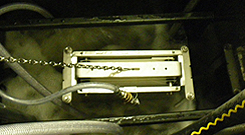Sewage and Effluent Treatment
Wastewater is the water that emerges after it is used for Domestic, commercial or Industrial purposes. The treatment techniques for Wastewater available are listed below.
Membrane Bioreactor (MBR)

Membrane bioreactor (MBR) is the combination of a membrane process such as Ultrafiltration with the activated sludge process or other biological processes. Secondary clarifiers and tertiary filtration processes are not required in MBR, thereby reducing plant footprint. They generate superior quality treated effluent with a high reuse potential. Membranes are submerged in the aeration tank Through which water is passed by negative pressure ultrafiltration. This is a sophisticated Technology and Aquatechnics is an experienced player in MBR technology.
Moving Bed Bioreactor (MBBR)
A technology commercialized by AnoxKaldnes, MBBR uses rectangular tanks in which aeration is used to agitate and move specially engineered plastic bio carriers. MBBR is an attached growth process where bacterial colonies are formed on the surface of the media for bio carriers. These bacteria carry out aerobic nutrient removal. The effluent after MBBR treatment is allowed to settle and then sent for tertiary filtration. A quaternary ultrafiltration can be combined with this technology to produce high quality treated effluent.
Sequential Batch Reactor (SBR)
Sequential batch reactors as the name indicates, are batch processes. The basis of technology is Activated Sludge Process. In these types of plants aeration and settling are done in a Single tank. This is achieved by operation in Batch Mode with a carefully crafted sequence which involves five stages; viz. Fill, React, Settle, Decant & Idle. Here also, a tertiary filtration and quaternary ultrafiltration is required to produce high quality effluent.
Submerged Aerobic Fixed Film Reactor (SAFF)
In SAFF process, raw effluent is introduced into the SAFF Reactor where the attached growth process takes place on the surface of PVC bio-media. The process is similar to MBBR, however the media is fixed and does not move around.
Anaerobic Bioreactors
The anaerobic process has been widely adopted for the treatment of high-strength wastewaters. Here, the bacteria employed are anaerobic type, meaning they survive by anaerobic cellular respiration. They don’t require energy supplied in tropical conditions and hence are very effective in reducing the high strength wastewaters to aerobically treatable levels. UASB (Upflow Anaerobic Sludge Blanket) reactors and attached growth HAF (High Rate Anaerobic Filter) are commonly used variants of Anaerobic type.
An-MBR / An-UF
Though this technology is still in its development stage, it is a promising one as it can combine the virtues of Anaerobic activity and membrane technology brought together. However, we have employed similar technology with chemically aided nutrient reduction as an additional step in some of our plants.
Electrocoagulation
Electrocoagulation (EC) is a treatment technology that removes total suspended solids (TSS), heavy metals, emulsified oils, bacteria and other contaminants from water by electrical means. This technique uses DC source between metal electrodes immersed in the effluent, which causes the dissolution of metallic electrode plates into the effluent. These metal ions, at an appropriate pH, can form a variety of coagulated mass and metal hydroxides that can destabilize and aggregate particles. EC has certain limitations in removing dissolved organic contaminants.
Zero Liquid Discharge Systems (ZLD)
Zero Liquid Discharge (ZLD) involves treatment processes designed to remove all the liquid waste from a system. The focus of ZLD is to reduce wastewater economically and produce clean water that is suitable for reuse, thereby saving money and being beneficial to the environment. In some Industrial processes, this involves Multiple Effect Evaporation and Crystallization of Solids which are then dried.
Advanced Oxidation Processes
These are chemical treatment procedures designed to remove organic (and sometimes inorganic) materials in water and wastewater by oxidation through reactions with hydroxyl radicals (·OH). Hydroxyl radicals are produced with the help of one or more primary oxidants (e.g. ozone, hydrogen peroxide).
Oil and Grease Removal
Wastewater from restaurants and other commercial food service facilities contain large concentrations of Fats, Oils and Greases. Most of the oil is in the form of free oil that can float to the surface and thus could be separated by gravity. Oil traps are engaged for the same. If there is a high amount of mechanically emulsified oil and if the system is large enough, we can use certain pre-treatment technologies for the elimination of the same.
Sludge Dewatering and Management
Sludge dewatering is the separation of solid rich phase from sludge whereby, generally, the least possible residual moisture is required in the solid phase and a clear filtrate is desired in liquid phase. There are several methods to treat sludge such as
- Digestors
- Drying Beds
- Filter Presses
- Screw Presses
- Centrifuges
- Belt dryers
Dissolved Air Flotation
Dissolved air flotation (DAF) is a method to clarify wastewater by the removal of suspended matter such as FOG (fats, Oils & Greases) and/or other impurities.